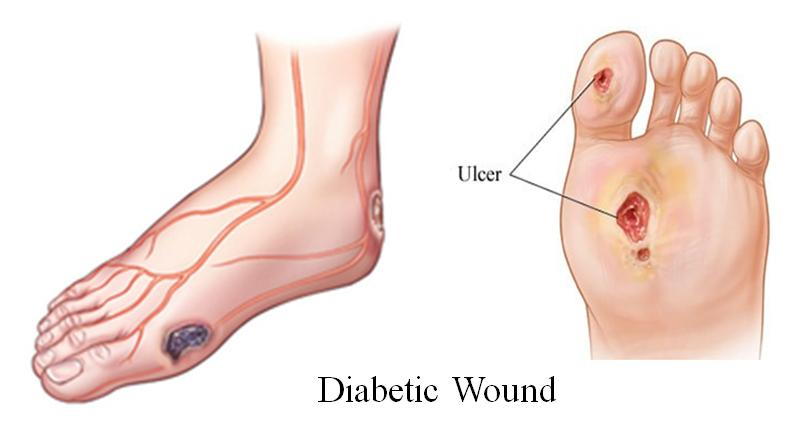
Diabetic foot disease
Long-term high blood sugar can cause a type of nerve damage called diabetes-related neuropathy. Diabetes-related neuropathy can occur throughout the body, but most often in the legs and feet.
The condition might make you lose feeling in your feet. If your feet are numb, you might not notice a blister, cut or sore. You might not even feel a pebble in your sock that is cutting your foot. Wounds that go unnoticed and untreated can become infected.
Diabetes can also affect blood flow to your legs and feet. People with diabetes are more likely to develop peripheral artery disease (PAD). This condition causes arteries to become narrowed or blocked. Reduced blood flow (poor circulation) can make it difficult for a diabetes-related foot ulcer or infection to heal.

What are the symptoms of diabetes-related neuropathy?
The signs of diabetes-related neuropathy may include:
- Darkened skin on the affected area.
- Diminished ability to sense hot or cold.
- Loss of hair in the area.
- Numbness.
- Pain.
- Tingling.
If diabetes-related neuropathy leads to foot ulcers, symptoms to watch out for include:
- Any changes to the skin or toenails, including cuts, blisters, calluses or sores.
- Discharge of fluid or pus.
- Foul smell.
- Pain.
- Redness.
- Skin discoloration.
- Swelling.
How are diabetes-related foot conditions diagnosed?
To diagnose diabetes-related foot conditions, a healthcare provider will:
- Ask about your symptoms and how well you’re managing blood glucose.
- Examine your toes, feet and legs.
- Touch the toes, feet and legs with various tools to check whether you have numbness.
If a diabetes-related ulcer or blister is present, the healthcare provider will likely:
- Examine it for any signs of infection, such as redness, swelling, warmth, discoloration or discharge.
- Order tests to take pictures deeper than the skin, such as X-ray or MRI.
- Take a sample of the skin or discharge to test for infection.
Manegement and Treatment
Treatment may include:
- Cleaning the wound.
- Draining any fluid or pus from the ulcer.
- Removing or cutting away dead or infected tissue (called debridement).
- Applying special bandages and ointments to absorb extra fluid, protect the wound and help it heal.
- Prescribing a wheelchair or crutches to take weight off the affected foot (called offloading).
- Prescribing oral or IV antibiotics to control and eliminate infection.
Depending on how severe the infection is, your healthcare provider may recommend hospitalization. Sometimes amputation is necessary to prevent infection from spreading to other parts of the body
Prevention
How can I reduce my risk of diabetes-related foot pain?
To avoid hyperglycemia and diabetes-related neuropathy, you should manage blood sugar carefully.
You can also reduce the risk of diabetes-related foot problems by:
- Checking your feet every day for any changes. Don’t forget to look between your toes. Ask someone for help or use a mirror if needed. Keeping a mirror at the foot end of the bed with good lighting, so that every day before going to sleep the patient is able to look out for any cracks or wound on his/her feet.
- Getting your feet checked at every visit with a healthcare provider.
- Keeping your toenails trimmed and filed. Cut them straight across to prevent ingrown toenails.
- Maintaining blood flow to the feet. For example, keep your feet elevated when you sit, and wiggle your toes often. Stay active, but choose activities that are gentler on the feet, such as walking or swimming.
- Putting talcum powder between the toes to prevent moisture buildup.
- Smoothing any corns or calluses.
- Wearing socks and shoes (or slippers) all day. Make sure your socks aren’t too tight and that your shoes fit properly. Some people with diabetes wear therapeutic shoes or shoe inserts to help prevent wounds or sores.
- Wearing specialized footwear made of MCR (microsellouse rubber) to prevent ulcer formation or progression on the feet.
- Washing your feet every day in warm water, not hot. Dry them thoroughly afterward, including between the toes. Then apply lotion to the tops and bottoms of the feet, but not between the toes.
It’s just as important to avoid certain things. Don’t:
- Cut calluses or corns or apply chemicals.
- Smoke.
- Soak your feet.
- Walk around barefoot.
- Wear tight socks or shoes.
Outlook and Prognosis
What is the outlook for people with diabetes-related foot conditions?
Diabetes-related foot ulcers are fairly common in people who have had diabetes for a long time. Even with foot checks and careful blood glucose monitoring, some people with diabetes develop infections.
The outlook depends on factors such as:
- How early the wound was found.
- Presence of infection and how much it spreads.
- Treatment effectiveness.
If the infection can’t be controlled and spreads too far, amputation may be necessary.
Have any Questions?
Reach out to know more details about the treatment.
- +91 8484803069
- +91 8605783349
- aestheticdna.goa@gmail.com
